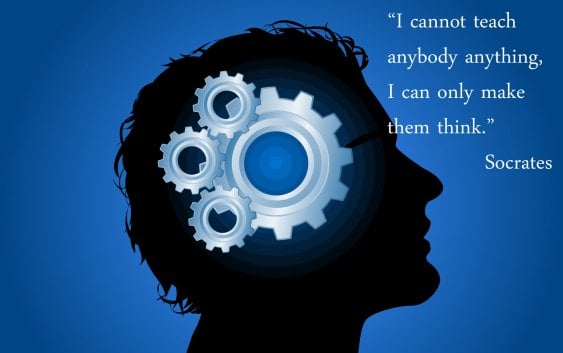The modern-day businesses are aware of the fact that the need for critical thinking is vital to their success. In our day to day professional lives, we take hundreds of decisions. We decide which road to take to work, what to wear, which phone calls to take, what to eat, etc. In the business scenario, several decisions have to be taken regarding whom to hire, which product to promote, how to promote a product, and so on. All such decisions need different directions of thinking, which may be creative, critical, or a combination of creative and critical thinking.
What is Critical Thinking?
Critical thinking is an analyzed and objective way to think for a problem. It includes taking into consideration aspects of logic and reasoning. Someone of a management position would need to use more critical thinking while making decisions that affect other individual’s jobs and processes, for example, safety procedures. While talking about the issues which deal with other individuals, critical thinking is required. For instance, when a manager is hiring new personnel, he or she needs critical thinking to analyze the candidates before deciding to accept or reject the candidate.
While finding joy and meaning about one’s work is useful for its productivity, it is even important to make sure that the intense emotions and the impulses do not cloud over the critical thinking at the workplace. Professionals should apply critical thinking in all of the aspects of workplace operations, to avoid any kind of costly and reoccurring mistakes. From recruitment to marketing to finance, all of the organizational departments must emphasize practicing critical thinking for undertaking any workplace decisions.
Jen Lawrence, the co-author of the famous book Engage the Fox: A Business Fable About Thinking Critically and Motivating Your Team, explains critical thinking as “An ability to solve the problems effectively by systematically collecting the information about the issue, generating the further ideas involving a wide variety of perspectives, evaluating all the information by making use of logic, and making sure that everyone involved is on the board.”
Critical thinking skills can be and must be taught in the workplace so that they become the second nature of the employees.
Critical thinking is an important part of the workplace as it ensures that the employees have the best answer to any problem, with a maximum buy-in of all the parties that are involved – an outcome that will ultimately save the business’s time, money as well as effort.
Process of Critical Thinking
Critical thinking is not as easy as a one-step action. It requires some detailed analysis and research. Critical thinking deals with solving problems through rational processes and evidence-based knowledge. Like any scientific method, critical thinking involves a lot of steps. But such steps help to save a lot of time in the long run when errors are avoided using such steps.
Critical thinking includes four major steps namely evaluation, assessment, categorization, and reasoning. Let’s understand each in detail in this blog.
Step 1 – Evaluation
This includes using logic to understand a problem in detail before coming up with a solution for the same.
Step 2 – Assessment
This includes considering the possible outcomes before taking any decision.
Step 3 – Categorization
This includes putting different solutions together based on their similarity before selecting any one of them.
Step 4 – Reasoning
This includes using logic to make decisions rather than being creative.
Teaching critical thinking at the workplace
Critical thinking is considered to be “a teachable skill.” It must be noted that critical thinking is generally miscategorized to be a soft skill, but not all the soft skills are teachable. If the employers and the employees don’t think that critical thinking is teachable, then it may be easy for it to be left out by the wayside. The individuals in the executive and managerial positions can start with an assessment of the areas of the workplace that seem to be the most lacking in critical thinking.

If the mistakes are being consistently made, then it is helpful to explore whether the issue is an absence of critical thinking and not an inherent issue with any employee or group of employees. Then, one can analyze what specific type of training, coaching or curriculum may fit the organization best. One can start by practicing critical thinking as a skill for smaller problems, and then work the way up to greater workplace challenges.
Approaching the problems with an independent, and reflective thought process is one type of critical thinking. The critical thinking creates arguments from the evidence while naming the problems and the assumptions that may get in the way of evaluating the issue for what it is. It is about solving problems in a process-centered way that capitalizes on the knowledge and objective of the shreds of evidence. In the business world, such kinds of skills help to save a great deal of time and money, right from the top to the bottom.
Not only does it save the business’s resources, but critical thinking would also enhance the other workplace skills, such as creativity, analytical competency, communication, emotional intelligence and general problem-solving.
Critical thinking helps you to save time and money
A 24-hour news cycle and loads of unchecked facts overload the brains in and out of the workplace. This contributes to a frantic workplace tempo which reinforces hasty thinking and can affect the ultimate business decisions. This is primarily when costly mistakes or blunders are being made.
Critical thinking makes an individual not only a better thinker but an even better communicator. Unless one can think clearly and articulate their positions, one can better engage people in the discussions and have a meaningful contribution to their job.
It might appear to be counterintuitive to connect analytical rationality with emotional as well as a meaningful contribution, but when one is feeling confident and thorough in their decision-making process, then their result may appear to be more fulfilling and hence yield out better emotional intelligence.
Just like the critical thinking processes themselves, the teaching and implementation of critical thinking training require time and patience. Critical thinking skills are best acquired at the time of calm. It may feel urgent to seek out to help via critical thinking during a crisis, but it is a difficult skill to master in a situation of panic. The training for Critical thinking is best to be done preemptively. In this way when a crisis hits the organization, the employees will be well prepared and critical thinking would appear more naturally.
From the executive or managerial perspective, providing employees extra time on a project or solving the problem may feel like a stressor to the organization if there are deadlines or pressures from the higher authorities. But if you want the employees working for you to engage in the critical thinking processes, then it is imperative to provide them with the time to do so. Some of the stress can be easily avoided if the skills of critical thinking are taught in advance, and not as a last resort. Providing employees with extra time would save the organization time and money in the long term.
Successful critical thinking implementation
Teaching the employees critical thinking at the workplace allows them to apply the skill as and when the crisis happens, and even in normal operations.

For instance, if a customer has a negative experience at a restaurant, the server using his critical thinking skills would be more likely to figure out the solution to save the interaction, like providing a free appetizer or offering a discount. This can help to save the hard-earned customer relationship for which the organization may have spent a lot on marketing.
The critical thinking concept is applicable across several business and organizational structures. The restaurant example does convey critical thinking skills; one must also be aware of the indicators of the lack of such skills. Organizations that change the strategy rapidly, moving from one step to the next, are likely to not engage in critical thinking. It is even in the case of the companies who seem to have great ideas but have trouble in executing the same.
Conclusion
As with several issues in the business, what is happening at the top is a good indicator of how the present critical thinking is in the remaining part of the organization. If the company has an intelligent leader who has great ideas but no processes being followed, then there will be no buying of the idea of critical thinking, and the organization will suffer. This is the reason why critical thinking skills are often accompanied by positive communication skills.
“Critical thinking does not just help one to arrive at the best answer, but to a solution, most people will embrace. Modeling critical thinking at the top would help the skill to trickle down to the remaining levels of the organization, no matter what type or size of the company one has.









